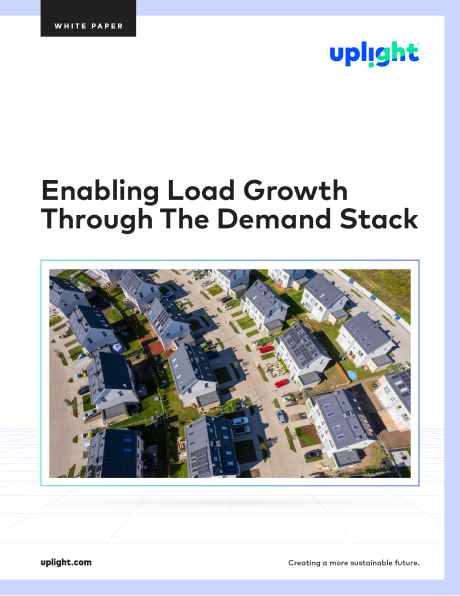Demand Management and Behavioral Energy Efficiency (BEE) programs have long been utilized by utilities as the most cost-effective form of capacity, oftentimes circumventing the need to build additional power plants. As part of Uplight’s Demand Stack offering, demand management helps shed and shift the load, while BEE helps shape the consumption patterns, enabling utilities to make the grid more resilient and efficient.
Most utilities are publicly regulated, where state and local governments have provided funding for and require demand side management programs. Measuring savings associated with these programs helps:
- Regulators: To prove the effectiveness of these programs that ratepayers usually fund
- Utilities: To understand the program performance and make adjustments to the program to reach efficiency goals, and also to incorporate results into forecasting and planning
- Customers: To determine the impact and to compensate for incentive program participation
Third-party evaluators do provide final savings calculations for these programs, but this process typically takes months after a program year ends. Uplight can deliver directional savings estimates much faster and more frequently, enabling utilities to track program performance and make necessary adjustments sooner if required.
In this installment of Meet the Models, I’ll discuss the models that enable Uplight to accurately measure program performance.
How Uplight’s Measurement Models Work
Measurement and verification (M&V) models are used to verify that a utility BEE program or demand management event (the “treatment”) has successfully achieved the energy reduction or shift intended, quantified by how much. Measurement models do this by simulating what would have happened in the absence of treatment (the “baseline”) and comparing this baseline to what actually occurred. Depending on the program requirements and treatment type, there are multiple ways this baseline may be generated.
For whole program population level measurement, this might be done by comparing a non-treated control population, either randomly assigned or generated through a matched control algorithm, or by modeling a population level baseline. If measurement is for a single household, this baseline may be modeled from that same household’s non-treatment period.
When creating a baseline, it must accurately represent the program or household being measured.
For demand response events: Verify that the baseline reflects conditions similar to the actual event day – for example, it represents usage on an extremely hot non-event day.
For population-level programs with control groups: Confirm that the control group is statistically similar and representative of the treatment group. Differences between the control and treatment groups are adjusted, or controlled for, to ensure the baseline generated represents the measured entity.
Measurement models leverage a mixture of usage, weather and time features. Depending on the program type, different types of measured usage data can be used including smart-meter energy readings, device telemetry, and billing data. Weather features such as temperature, alongside time variables like hour of day, can be used to create a representative baseline for the treatment period.
At Uplight, measurement and verification models are leveraged across product offerings to prove effectiveness and to measure impact. All measurement methods rely on modeling what would have happened without treatment to measure program effectiveness.
Value of Uplight’s Measurement Models
Two primary applications of measurement models at Uplight are assessing performance of monthly Home Energy Reports (HER)s for BEE and demand side programs such as automated and behavioral demand response.
Home Energy Report M&V
HERs are Uplight’s primary BEE solution for utilities. As part of program implementation, we ingest consumption data regularly from the utilities, transforming it into a standardized format. We then create the experimental designs for each program by setting up randomized control trials, measuring the savings associated with each program, and finally reporting the savings to utilities using standardized methods defined by NREL.
Uplight receives a continual data ingest from our utility partners, enabling us to provide frequent directional savings estimates to help utilities monitor program performance more closely and make quick adjustments when needed. While utilities usually rely on third-party evaluators to calculate final savings, Uplight streamlines this process by providing evaluators with the experiment setup and cleaned data. This saves utilities time, cost and effort of data wrangling.
Load Management M&V
Once a load management event has taken place, utilities can leverage Uplight’s platform to run M&V jobs and generate event reports and visualizations within contractual time requirements. This enables quick feedback on end-customer participation and event performance. Additionally, household-level results can help utilities determine how to compensate participants enrolled in the program.
Uplight offers out-of-the-box, configurable baselining options that utilities can adjust to meet their needs, including the ability to measure against multiple baselines. These include industry standard M&V methodologies:
- High/Middle X of Y: This baseline method takes the last Y days and takes an average of the highest or middle X days to generate the baseline value.
- Matching Day Pair: This method is similar to X of Y, but instead of looking at the last Y days, historical data is analyzed to identify optimal day pairs to use.
- Preceding Base Point: This baseline method determines the consumption in the interval before an event and uses that as a constant baseline.
- Weather Based Regression: This baseline method uses historical weather data and historical meter data to generate a regression-based model, which then is used to generate a baseline by predicting the load on the event day based on weather, time-of-day, and other features.
The ability for a utility to select and configure one or more M&V methods is especially valuable as the best-suited baselining method varies with program type, event type, and geographic region. This flexibility also allows for close alignment with regulator requirements and regional industry standards.
Uplight has a wide offering of measurement models, estimating both demand and consumption savings to get the most accurate measurement possible. Getting accurate performance results sooner is more important than ever, especially as utilities expand programs and want to get the most MWh out of them. Also, customers want their incentives for participating sooner (and this reinforces participation)





